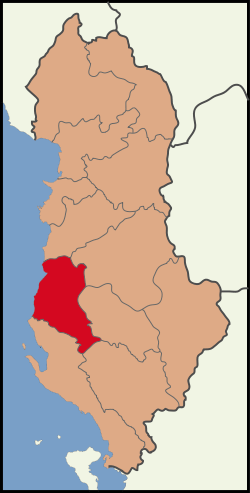Lushnjë
| Lushnjë | |
|---|---|
| Municipality | |
.jpg) | |
 Lushnjë | |
| Coordinates: 40°56′N 19°42′E / 40.933°N 19.700°ECoordinates: 40°56′N 19°42′E / 40.933°N 19.700°E | |
| Country |
|
| County | Fier |
| Government | |
| • Mayor | Fatos Tushe |
| Elevation | 9 m (30 ft) |
| Population (2011) | |
| • Total | 31,105 |
| Time zone | CET/CEST (UTC+1/+2) |
| Postal code | 9001 |
| Area code | 035 |
| Car plates | LU |
| Website |
www |
Lushnjë (Albanian pronunciation: [ˈluʃɲə]) (Lushnje (ˈluʃɲe) in Lushnjë's own dialect) is a city in Central-West Albania. It is located in the County of Fier.[1] The population at the 2011 census was 31,105.[2] The town was founded in late medieval times by a widow called Salushe. She built a rest stop called Hani i Salushes on the road from Durrës to Berat and Fier, giving birth to the town. As of 2000, old men still called the town Salushe. Lushnjë is the only town in Albania founded by a woman.
In January 1920, Lushnjë was a provisional capital of Albania and the place of the Congress of Lushnjë. Chieftains of Albania assembled in the town and declared Tirana first a provisional and then the definitive capital of Albania.
The Lushnjë region is known as a main provider of agricultural products to the rest of the country. It is one of very few field districts of mountainous Albania.
During the Communist Regime the town had a number of factories: among them food processing and building materials, which were closed down for one reason or another in the aftermath of the fall of Communism. Stadium of Lushnjë Abdurrahman Roza Haxhiu was the only stadium in the country where women were soccer fans as much as men were, and attended the soccer matches. This shows that the town was exceptionally liberal, peaceful and emancipated. Unfortunately that tradition has expired, and now Lushnjë resembles all the neighboring towns.
3 km away from Lushnjë is the Savra Field. This field is on the Lushnjë-Fier road. Here the first battle between Principality of Zeta and Ottoman Empire occurred in 1385 (the Battle of Savra). In this battle Balsha II was killed. Along with Fier, Lushnjë was the main district of the concentration camps during the Communist Regime; some of the camps included the villages of Savër, Gradishtë, Bedat, Gjazë, Rrapëz, Plug, etc.
Data from the 1918 census shows that the population of Lushnjë was split almost evenly between Muslims and Christians at the time of independence from the Ottoman Empire. [3] The Christians are mostly Orthodox, but there is a Catholic minority, while similarly the Muslims are mostly Sunni with a Bektashi minority. In modern days, like elsewhere in Albania, people in Lushnja tend not to be very religious if religious at all, regardless of whatever religion their ancestors professed.
Notable landmarks
Notable landmarks include Abdurrahman Roza Haxhiu Stadium, Vaçe Zela theater, Lushnjë Catholic Church, Lushnjë Mosque, Congress of Lushnjë Museum, Lushnjë History Museum.
Notable people
- Abdurrahman Roza Haxhiu, footballer
- Gezim Hajdari, poet and writer
- Lindita Arapi, poet and writer living in Germany
- Vaçe Zela, singer
- Hysni Zela, singer
- Margarita Xhepa, actress
- Bajram Haxhiu, founding father of modern Albania
- Qemal bej Mullai, founding father of modern Albania
- Ferit bej Vokopola, founding father of modern Albania
- Nebi Efendi Sefa, founding father of modern Albania
Twin towns - Sister cities
Mayors of Lushnjë
- Kujtim Haxhiu 1992-1996
- Agim Fuga 1996-1999
- Ylli Myftiu 1999-2003
- Kadri Gega 2003-2007
- Albert Sanxhaku 2007-2011
- Fatos Tushe 2011-2015
References
- ↑ Municipality of Lushnjë (2010). "Plani rregullues" (in Albanian). Retrieved 3 September 2010.
- ↑ 2011 census results
- ↑ Siegfried Gruber. "Regional variation in marriage patterns in Albania at the beginning of the 20th century". www-gewi.uni-graz.at. Retrieved 2014-06-11., Seiner's 1918 data mapped here: http://www-gewi.uni-graz.at/seiner/density.html
External links
| Wikimedia Commons has media related to Lushnjë. |
| |||||||||||||||||||||
